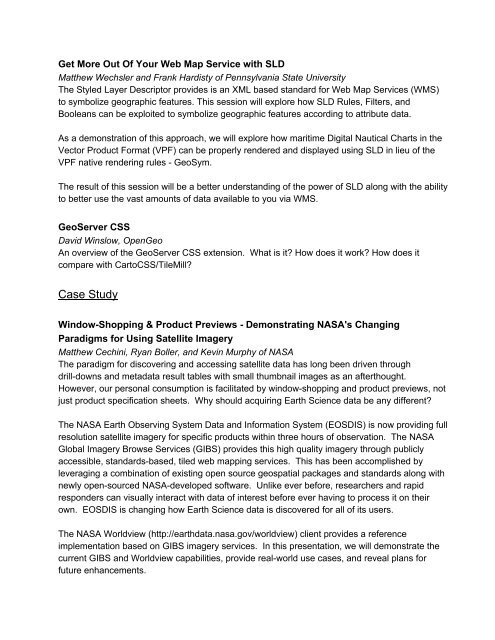FOSS4G North America Conference 2013 Preliminary Program
FOSS4G North America Conference 2013 Preliminary Program
FOSS4G North America Conference 2013 Preliminary Program
You also want an ePaper? Increase the reach of your titles
YUMPU automatically turns print PDFs into web optimized ePapers that Google loves.
Get More Out Of Your Web Map Service with SLD<br />
Matthew Wechsler and Frank Hardisty of Pennsylvania State University<br />
The Styled Layer Descriptor provides is an XML based standard for Web Map Services (WMS)<br />
to symbolize geographic features. This session will explore how SLD Rules, Filters, and<br />
Booleans can be exploited to symbolize geographic features according to attribute data.<br />
As a demonstration of this approach, we will explore how maritime Digital Nautical Charts in the<br />
Vector Product Format (VPF) can be properly rendered and displayed using SLD in lieu of the<br />
VPF native rendering rules GeoSym.<br />
The result of this session will be a better understanding of the power of SLD along with the ability<br />
to better use the vast amounts of data available to you via WMS.<br />
GeoServer CSS<br />
David Winslow, OpenGeo<br />
An overview of the GeoServer CSS extension. What is it? How does it work? How does it<br />
compare with CartoCSS/TileMill?<br />
Case Study<br />
WindowShopping & Product Previews Demonstrating NASA's Changing<br />
Paradigms for Using Satellite Imagery<br />
Matthew Cechini, Ryan Boller, and Kevin Murphy of NASA<br />
The paradigm for discovering and accessing satellite data has long been driven through<br />
drilldowns and metadata result tables with small thumbnail images as an afterthought.<br />
However, our personal consumption is facilitated by windowshopping and product previews, not<br />
just product specification sheets. Why should acquiring Earth Science data be any different?<br />
The NASA Earth Observing System Data and Information System (EOSDIS) is now providing full<br />
resolution satellite imagery for specific products within three hours of observation. The NASA<br />
Global Imagery Browse Services (GIBS) provides this high quality imagery through publicly<br />
accessible, standardsbased, tiled web mapping services. This has been accomplished by<br />
leveraging a combination of existing open source geospatial packages and standards along with<br />
newly opensourced NASAdeveloped software. Unlike ever before, researchers and rapid<br />
responders can visually interact with data of interest before ever having to process it on their<br />
own. EOSDIS is changing how Earth Science data is discovered for all of its users.<br />
The NASA Worldview (http://earthdata.nasa.gov/worldview) client provides a reference<br />
implementation based on GIBS imagery services. In this presentation, we will demonstrate the<br />
current GIBS and Worldview capabilities, provide realworld use cases, and reveal plans for<br />
future enhancements.


